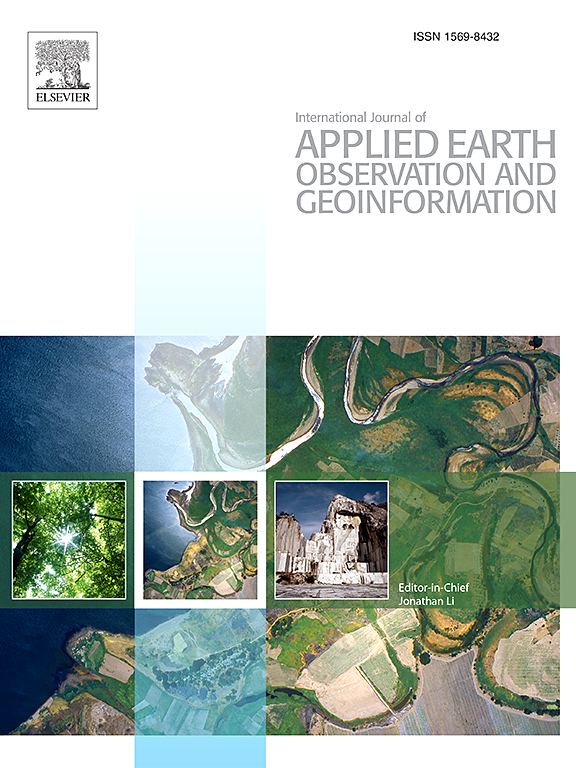D3GNN:用于多源遥感数据分类的双对偶动态图神经网络
IF 7.6
Q1 REMOTE SENSING
International journal of applied earth observation and geoinformation : ITC journal
Pub Date : 2025-04-01
DOI:10.1016/j.jag.2025.104496
引用次数: 0
摘要
卷积神经网络(CNN)因其在多源遥感(RS)图像分类中的突出表现而备受关注。然而,经典的基于cnn的方法主要集中在固定大小的邻域和标准正方形区域内的信息,忽略了远程和全局信息。拓扑结构作为非欧几里得数据,可以灵活地构建对象之间的关系,可以作为全局信息的有效载体。图神经网络(GNN)能够从拓扑结构中提取特征,被认为是捕获全局信息的一种解决方案。然而,GNN面临着手动定义的静态图结构可能无法准确捕获数据复杂性的挑战。提出了一种基于动态拓扑结构改进的双对偶动态图神经网络(D3GNN)用于多源遥感数据分类。D3GNN通过利用局部空间信息和不同来源的独特数据,生成多个拓扑结构,实现对场景特征的综合感知。针对异构结构数据的特点,D3GNN实现了有针对性的拓扑结构重构和细化,克服了静态图的局限性,使网络生成的特征嵌入具有更强的判别能力。实验结果表明,与现有方法相比,D3GNN具有优越的性能。本文章由计算机程序翻译,如有差异,请以英文原文为准。
D3GNN: Double dual dynamic graph neural network for multisource remote sensing data classification
Convolutional Neural Network (CNN) has garnered attention due to its outstanding performance in multisource remote sensing (RS) image classification. However, classical CNN-based methods primarily concentrate on information within a fixed-size neighborhood and a standard square region, neglecting long-range and global information. As non-Euclidean data, the topological structure enables flexible construction of relationships between objects, which can be served as an effective carrier of global information. Graph Neural Network (GNN), capable of extracting features from the topological structure, is considered as a solution for capturing global information. Nevertheless, GNN faces challenges as the manually defined static graph structure might not accurately capture the complexity of the data. We propose a double dual dynamic graph neural network (DGNN) with dynamic topological structure refinement for multisource RS data classification. DGNN generates multiple topological structures to achieve a comprehensive perception of scene features by utilizing local spatial information and distinctive data from various sources. Given the characteristics of heterogeneous-structure data, DGNN implements targeted topological structure remodeling and refinement to overcome the limitations imposed by static graph, thereby enabling the network to generate feature embeddings with enhanced discriminative power. The experimental results show that DGNN achieves superior performance compared to other current methods.
求助全文
通过发布文献求助,成功后即可免费获取论文全文。
去求助
来源期刊

International journal of applied earth observation and geoinformation : ITC journal
Global and Planetary Change, Management, Monitoring, Policy and Law, Earth-Surface Processes, Computers in Earth Sciences
CiteScore
12.00
自引率
0.00%
发文量
0
审稿时长
77 days
期刊介绍:
The International Journal of Applied Earth Observation and Geoinformation publishes original papers that utilize earth observation data for natural resource and environmental inventory and management. These data primarily originate from remote sensing platforms, including satellites and aircraft, supplemented by surface and subsurface measurements. Addressing natural resources such as forests, agricultural land, soils, and water, as well as environmental concerns like biodiversity, land degradation, and hazards, the journal explores conceptual and data-driven approaches. It covers geoinformation themes like capturing, databasing, visualization, interpretation, data quality, and spatial uncertainty.
 求助内容:
求助内容: 应助结果提醒方式:
应助结果提醒方式:


